ECLIPTA
Eclipta
L., Mant. Pl. 2: 157,286. 1771; Fl. China @ eFloras.org 20-21: 869; Strother, Fl. North Amer. @ eFloras.org 21: 128; Hook. f., Fl. Brit. Ind. 3: 304. 1882.
Annual or perennial herbs. Stem erect or decumbent, branched, glabrous or strigose. Leaves cauline, opposite, sessile or petiolate, blade lanceolate to linear-lanceolate, base cuneate, margin entire or toothed. Capitula radiate, heterogamous, in loose corymbiform arrays or borne singly, axillary or terminal. Involucre campanulate or hemispheric; phyllaries persistent, 8-12+ in 2 or 3 series, imbricate; receptacle flat or convex, paleaceous, paleae awn-like. Ray florets: 20-40 in 2 or 3 series, bisexual, mostly fertile Corolla white to yellowish; limb minutely 2-lobed. Disc florets: 15-30+, bisexual, fertile. Corolla greenish white to yellowish, tubular; tube much shorter than ampliated (widened, enlarged) cylindrical throats, 4- or rarely 5-lobed, +/- deltate. Anthers entire or very shortly bifid at base. Style branches obtuse, mammillate at apex. Cypselae thick, maturing and falling rapidly; those of ray florets 3-angled, those of disc florets compressed, 4-angled, coarsely hairy, tuberculate, margin with 1-3minute teeth, apex truncate and depressed. Pappus coroniform or of 2-3 awns.
6 species
Eclipta prostrata
Eclipta prostrata
(L.) L., Mant. Pl. 2: 286. 1771; Sharma & Kachroo, Fl. Jammu (Illustr.) 2: t. 132. 1983; Kaur & Sharma, Fl. Sirmaur 372. 2004; Singh & Sharma, Fl. Chamba Dist. 406. 2006; Fl. China @ eFloras.org 20-21: 869; Fl. North Amer. @ eFloras.org 21: 129; Verbesina alba L., Sp. Pl. 902. 1759; Eclipta alba (L.) Hassk., Pl. Java Rar. 528. 1848; Hook. f., Fl. Brit. Ind. 3: 304. 1882; Collett, Fl. Siml. ed. 2. 262. 1921 (Reprint 1980); E. erecta L., Mant. Pl. 2: 286. 1771.
Annual herbs. Stem terete, erect, ascending or prostrate, 30-60 cm long, strigose-pilose, branched at base, often rooting at base. Leaves cauline, opposite, sessile or subsessile; leaf blade lanceolate, oblong-lanceolate or elliptic-oblong, 3-8 cm x 0.5-1.5 cm, papery, densely strigose-pubescent on both surfaces, apex gradually acuminate or acute, margin nearly entire or serrulate, base narrowed. Capitula radiate, 6-8 mm across, solitary, axillary and terminal on 1.8-4 cm long erect, slender peduncle, peduncle appressed-strigose; involucre globose- campanulate, ca. 5 mm x 6-7 mm enlarging to 10+ mm wide in fruit; phyllaries 5, 6 or 8, 2-seriate, oblong to ovate-lanceolate, acute, outer +/- 5.5 mm long, inner slightly shorter, +/- 4.5 mm long. Receptacle convex, paleate, paleae slender, awn-like, 2-3 mm long, hairy in upper 2/3rd portion, persistent even after the cypselae drop off. Ray florets: 20-40+, fertile, in 2-3 series, limb ligulate, tube ca. 0.8 mm long; limb 2-2.5 mm x 0.3-0.4 mm, 2 obtuse-tipped-lobed or entire, white to yellowish. Ovary 1.1-1.2 mm long, hairy at apex, style branches 2. Disc florets: Many, 15-30+, bisexual, fertile. Corolla tubular, greenish white to yellowish; tube much shorter (ca. 1 mm long) than ampliated cylindrical throats, 2-2.5 mm long, lobes 4 or 5, 0.5 mm long, deltoid, white. Anthers with spatulate tips, incurved, subauriculate at base. Ovary 1.1-1.2 mm long, hairy at apex, style branches 2, pubescent. Cypselae yellowish brown to brown, dorsi-ventrally compressed and sharply angled, ca. 2.5 mm x 1.5 mm, narrow oblong, 4-angled, angles indurated, faces coarsely tuberculate, apex truncate, depressed. Pappus teeth 2-3, +/- 0.15 mm long, partially or completely united forming a cone at apex.
Common Names: False Daisy, Trailing Eclipta, Thistles; Bhringraj, Keshraj (Hindi)
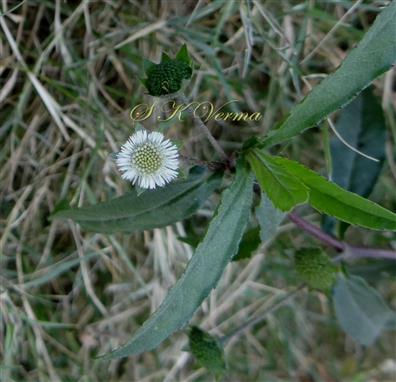
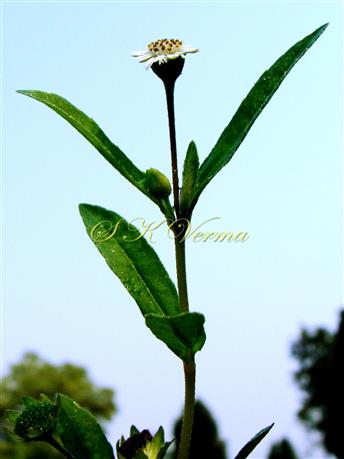
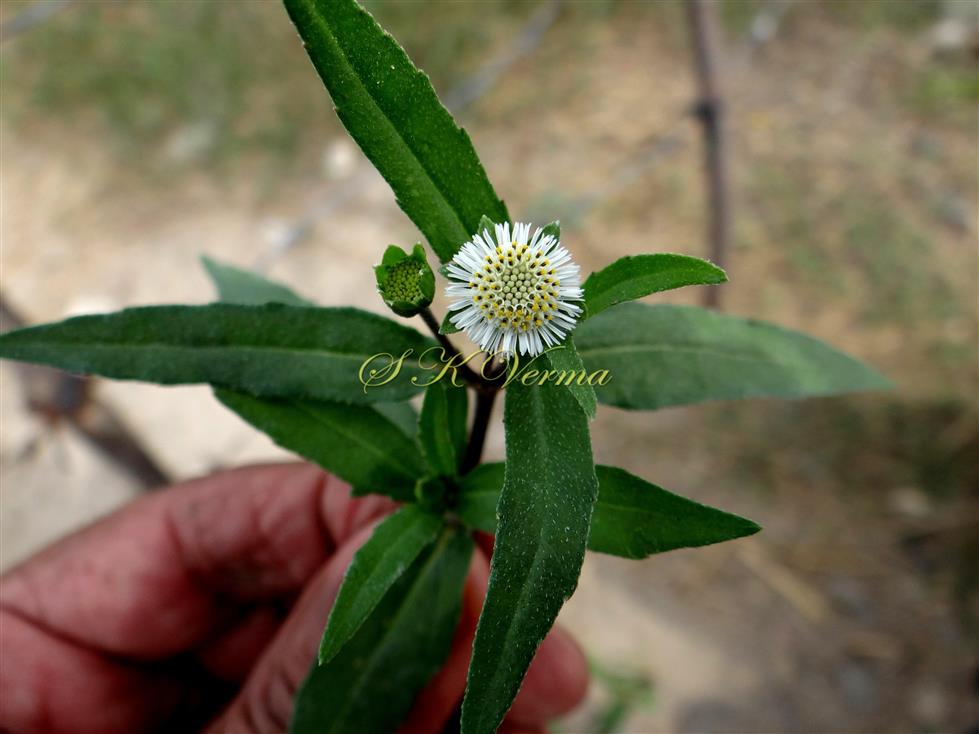
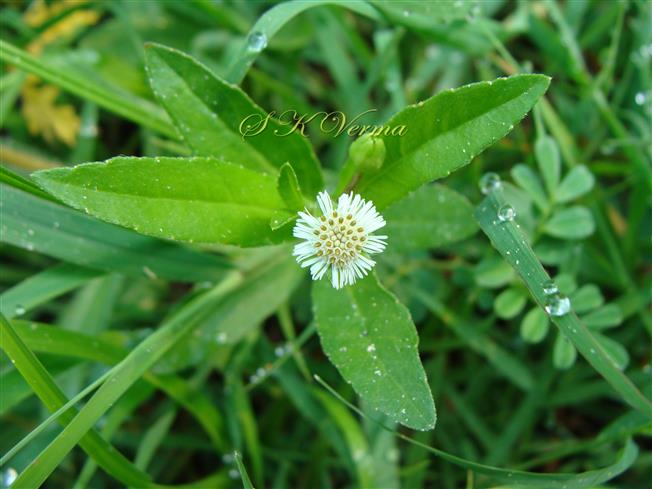
-DSC00806.jpg)
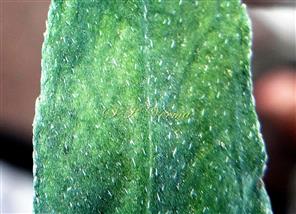
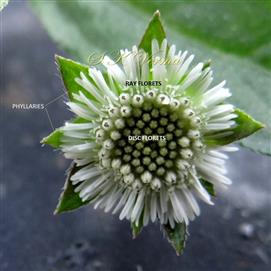
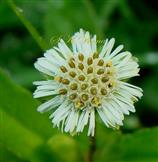
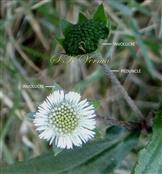
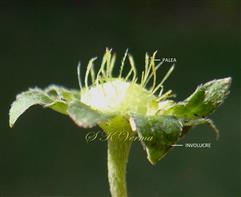
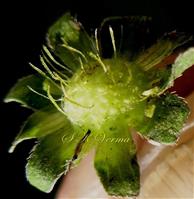
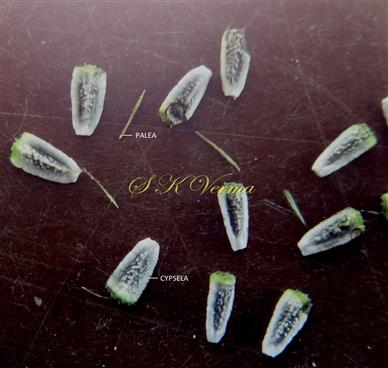
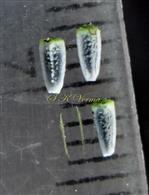





-DSC00806.jpg)







